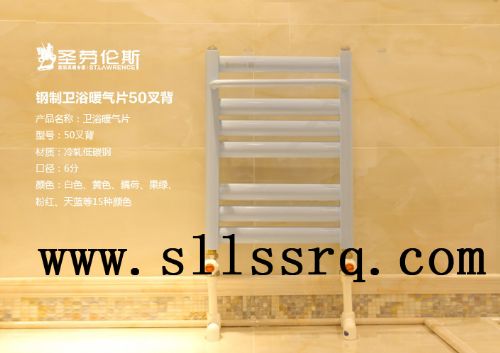Tell you why choose steel radiator
Among various kinds of heating equipment, copper-aluminum composite radiators have always been recognized as excellent in heat dissipation performance, and have accelerated into ordinary families in recent years. In fact, the heat dissipation performance of the radiator during use is affected by many factors, and it cannot be attributed to product quality. Now, the radiator manufacturer St. Lawrence came to talk about everyone, and the cooling performance of the copper-aluminum composite radiator is related to what factors.

First, the copper-aluminum composite radiator thermal performance and material related to the scientific determination of the metal thermal conductivity performance from the order of the largest: copper (401 W/mK), aluminum alloy (237 W/mK), steel (80 W / mK), stainless steel (W/mK), the greater the thermal conductivity, the better the thermal conductivity. The copper-aluminum composite radiator adopts copper and aluminum as raw materials, has good heat conduction performance, large heat dissipation, rapid heat dissipation, and low carbon energy consumption.
Second, the thermal performance of copper-aluminum composite radiators and heat dissipation area We all know this common sense: the greater the heat dissipation area, the more conducive to heat, copper and aluminum composite radiators make good use of this principle. From the structural point of view, compared to other types of radiators, the design of copper-aluminum composite radiators is unique. In general, cooling fins are added on the back, which increases the cooling area by more than 20%. At the same time, the top buckle design facilitates heat dissipation, making radiators Heat dissipation is faster.
Third, the thermal performance of the copper-aluminum composite radiator and the room insulation performance We will find that in the winter heating, although the same radiator products are used, some users have high temperature at home and some are low. This is mainly due to the fact that The insulation properties of the room are different. If the insulation effect of the room is not good, a large amount of heat will be lost to the outside, and the outdoor cold air will also flow into the room in large quantities, resulting in insufficient heat load in the room and the room temperature will not reach the ideal temperature.
Fourth, the thermal performance of the copper-aluminum composite radiator and the system water temperature copper-aluminum composite radiator will be used in closed heating systems, water as a heat carrier, connected through the pipeline, and ultimately rely on the radiator to the appropriate temperature output . From this, it can be seen that the heat dissipation effect of the radiator largely depends on the temperature of the incoming and outgoing water. For self-heating users, it is possible to adjust the water temperature of the boiler freely by adjusting the outlet water temperature of the boiler, so that the room temperature can be controlled in the most comfortable state.
From the above analysis, it can be seen that the heat dissipation effect of copper-aluminum composite radiator mainly depends on the material, heat dissipation area, room insulation performance, system water temperature and other factors. Users need to pay attention to the above problems when purchasing and using, to prevent the heating effect is not ideal. Can not meet the heating needs well.

First, the copper-aluminum composite radiator thermal performance and material related to the scientific determination of the metal thermal conductivity performance from the order of the largest: copper (401 W/mK), aluminum alloy (237 W/mK), steel (80 W / mK), stainless steel (W/mK), the greater the thermal conductivity, the better the thermal conductivity. The copper-aluminum composite radiator adopts copper and aluminum as raw materials, has good heat conduction performance, large heat dissipation, rapid heat dissipation, and low carbon energy consumption.
Second, the thermal performance of copper-aluminum composite radiators and heat dissipation area We all know this common sense: the greater the heat dissipation area, the more conducive to heat, copper and aluminum composite radiators make good use of this principle. From the structural point of view, compared to other types of radiators, the design of copper-aluminum composite radiators is unique. In general, cooling fins are added on the back, which increases the cooling area by more than 20%. At the same time, the top buckle design facilitates heat dissipation, making radiators Heat dissipation is faster.
Third, the thermal performance of the copper-aluminum composite radiator and the room insulation performance We will find that in the winter heating, although the same radiator products are used, some users have high temperature at home and some are low. This is mainly due to the fact that The insulation properties of the room are different. If the insulation effect of the room is not good, a large amount of heat will be lost to the outside, and the outdoor cold air will also flow into the room in large quantities, resulting in insufficient heat load in the room and the room temperature will not reach the ideal temperature.
Fourth, the thermal performance of the copper-aluminum composite radiator and the system water temperature copper-aluminum composite radiator will be used in closed heating systems, water as a heat carrier, connected through the pipeline, and ultimately rely on the radiator to the appropriate temperature output . From this, it can be seen that the heat dissipation effect of the radiator largely depends on the temperature of the incoming and outgoing water. For self-heating users, it is possible to adjust the water temperature of the boiler freely by adjusting the outlet water temperature of the boiler, so that the room temperature can be controlled in the most comfortable state.
From the above analysis, it can be seen that the heat dissipation effect of copper-aluminum composite radiator mainly depends on the material, heat dissipation area, room insulation performance, system water temperature and other factors. Users need to pay attention to the above problems when purchasing and using, to prevent the heating effect is not ideal. Can not meet the heating needs well.
WPC Series,WPC Decking Floor,WPC Board,WPC Sheet
Linyi Fengzhize Trading Co., Ltd. , https://www.fengzhize.com
